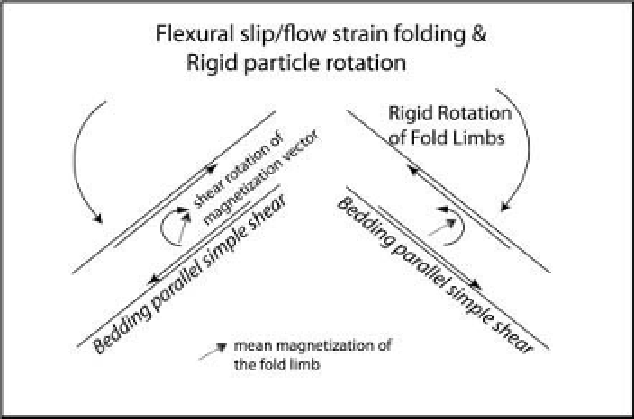Geology Reference
In-Depth Information
Fig. 7.5
The effect of fl exural slip/fl ow folding strain on a magnetization if it rotates as if carried by rigid particles by Jeffery's
(1923) equation. Note that the sense of magnetization rotation is opposite to the rigid body rotation of the fold limbs, causing
a pre-folding magnetization to be rotated into a syn-folding confi guration.
fold; only very steep-inclination initial paleomagnetic
directions will be rotated to appear syn-folding (Fig.
7.6). The mechanism by which magnetizations rotate
at the grain scale, either passive line or rigid particle,
becomes extremely important in understanding the
effects of fl exural slip/fl ow strain on interpretation of
the fold test.
The bulk fl attening of a fold by homogeneous strain
is a special case of remanence rotation as a passive
marker in fl exural fl ow strain, because the vertical
strain ellipses that result from the homogeneous fl at-
tening are similar in orientation to those that arise
from fl exural fl ow.
An entirely different folding strain confi guration
that could affect the magnetization of a fold is
tangential-longitudinal strain. In this case, simple
shear does not occur during folding. Therefore, only
passive line marker rotation of the remanence
was considered by Kodama (1988). In tangential-
longitudinal strain the outer arc of the fold undergoes
bedding-parallel extension and the inner arc of the fold
undergoes bedding - parallel compression (Fig. 7.7 ).
Using numerical modeling, Kodama considered the
effects of this strain when one limb was sampled under
the neutral surface in the bedding-parallel compres-
sion regime and the other limb was sampled above the
neutral surface in the bedding-parallel extension
regime. He also considered the case where both limbs
were sampled above and below the neutral surfaces.
Magnetizations were rotated into the extensional
axes of the strain ellipses by Wettstein's equation.
Only in the special case of sampling one limb above
and one limb below the neutral surfaces could a
syn-folding magnetization result from a pre-folding
magnetization. Fold curvatures of approximately
40% for initially intermediate inclinations were needed
for the most pronounced syn-folding magnetization
confi gurations.
Finally, Kodama (1988) considered the effects of dis-
continuous deformation during folding: the formation
of axial planar cleavage. The volume loss in the cleav-
age domains leads to an oversteepening of the fold
limbs with respect to the bedding planes within the
undeformed microlithons between the cleavage planes.
If the oversteepened limbs are used to untilt the paleo-
magnetic directions in each limb, a syn-folding mag-
netization can result from a pre-folding magnetization.
Kodama's modeling found that a volume loss of about
50% for limb dips between 30 and 60° could lead to
a maximum clustering of directions at about 50%
unfolding. Smaller volume losses will lead to best clus-
tering at partial unfoldings closer to 100%. If the best
clustering occurs at partial unfoldings of 85% or
greater, the magnetization will not be distinguishable
from pre-folding using the McFadden & Jones (1981)
statistical test.





Search WWH ::

Custom Search